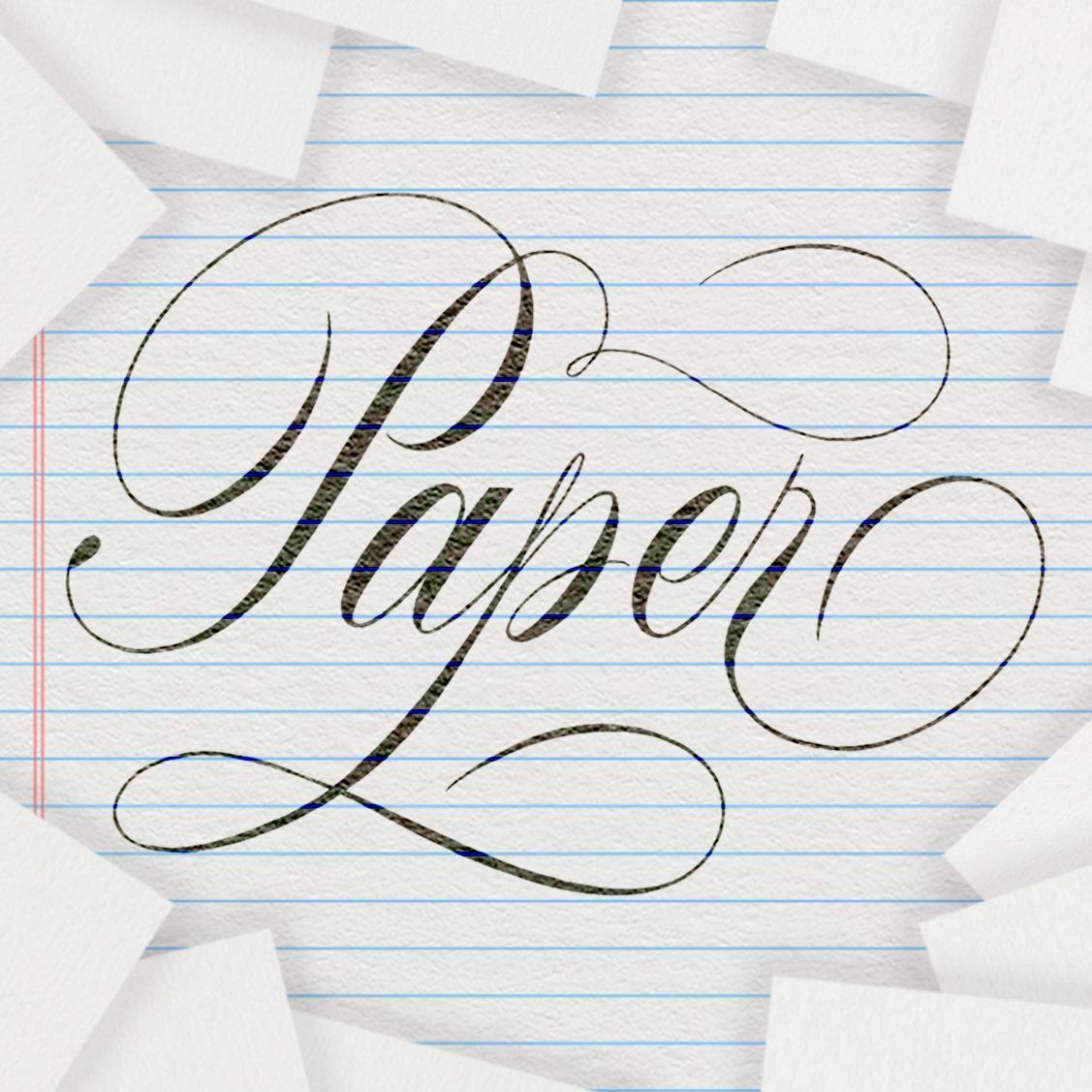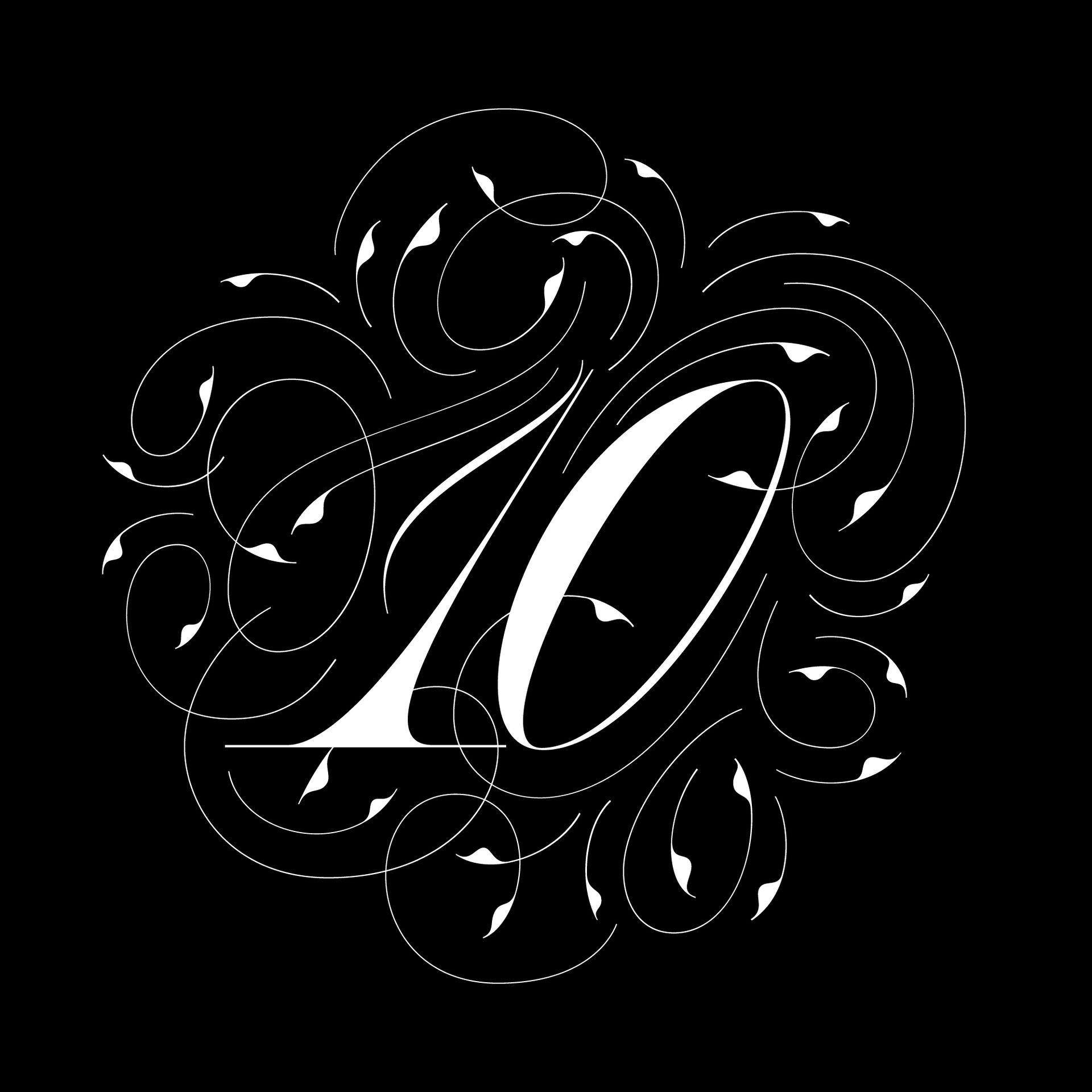A Guide to Calligraphy Pens: Choosing the Right Writing Tools for Your Practice
Let's talk about calligraphy pens a little more in-depth! And let’s start with its definition: Any writing or drawing instrument designed to deliver liquid medium to a surface.
Beyond contemporary markers and mechanical pens, calligraphers typically prefer dip pens for refined work, where precision and delicacy of stroke are crucial.
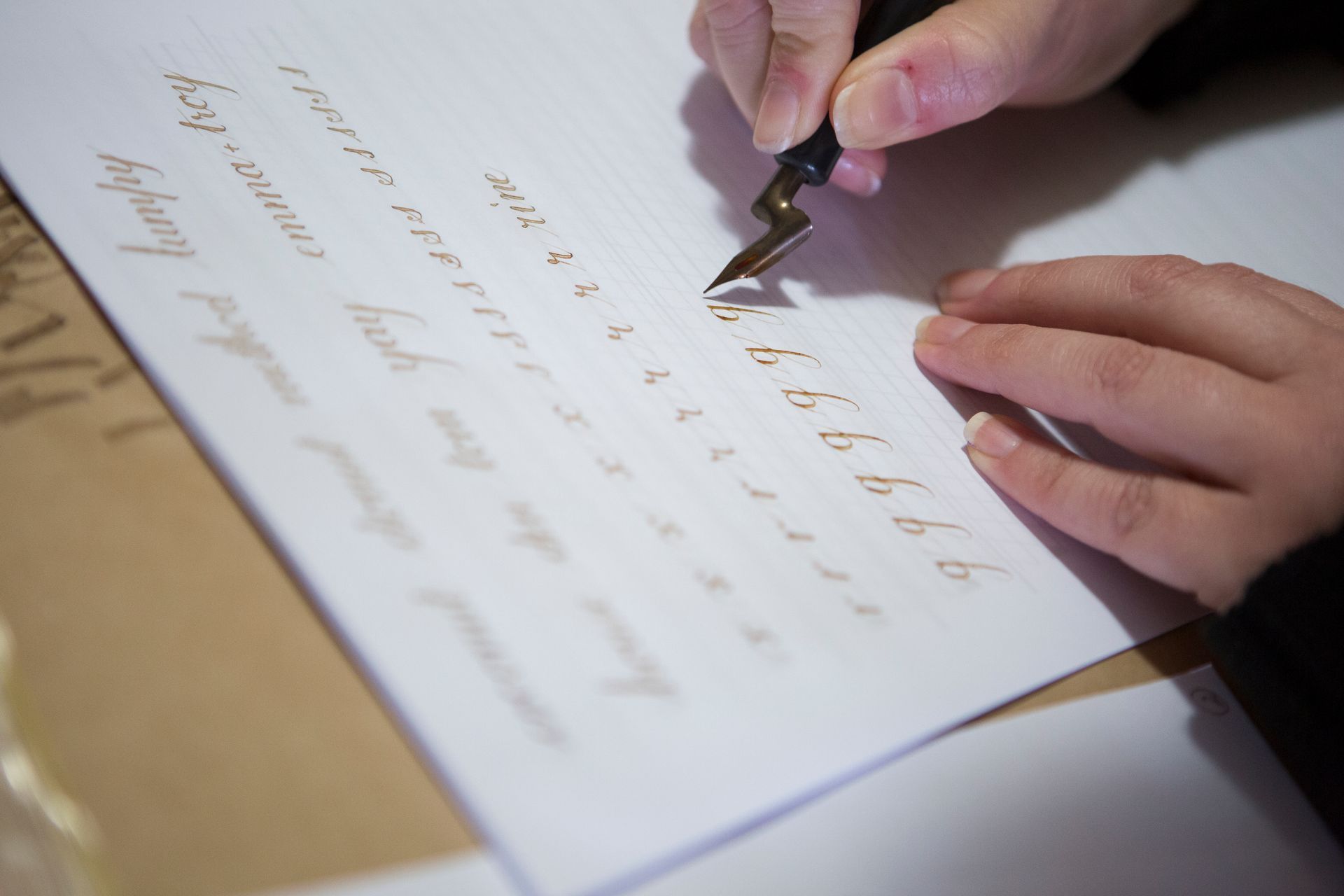
Photo credit: Mark Lobo at Rotson Studios, Naarm (Melbourne).
What Is a Dip Pen in Calligraphy?
A dip pen is a writing instrument with a detachable metal nib that must be dipped into ink before writing or drawing. Unlike fountain pens, dip pens do not have an internal ink reservoir/ink cartridge.
These pens are commonly used in calligraphy, illustration, and fine art due to their ability to create expressive strokes and varying line widths.
The versatility of dip pens is remarkable - they can be used with different types of ink, including:
- Metallic inks
- Watercolours
- Walnut ink
- Gouache
- Japanese ink (Sumi ink), Chinese ink
This versatility makes them an essential tool for artists and calligraphers seeking expressive line work.
In most cases, a dip pen is composed of a pen holder and a detachable metal nib, with the exceptions of bamboo/reed pens and old-school quills.
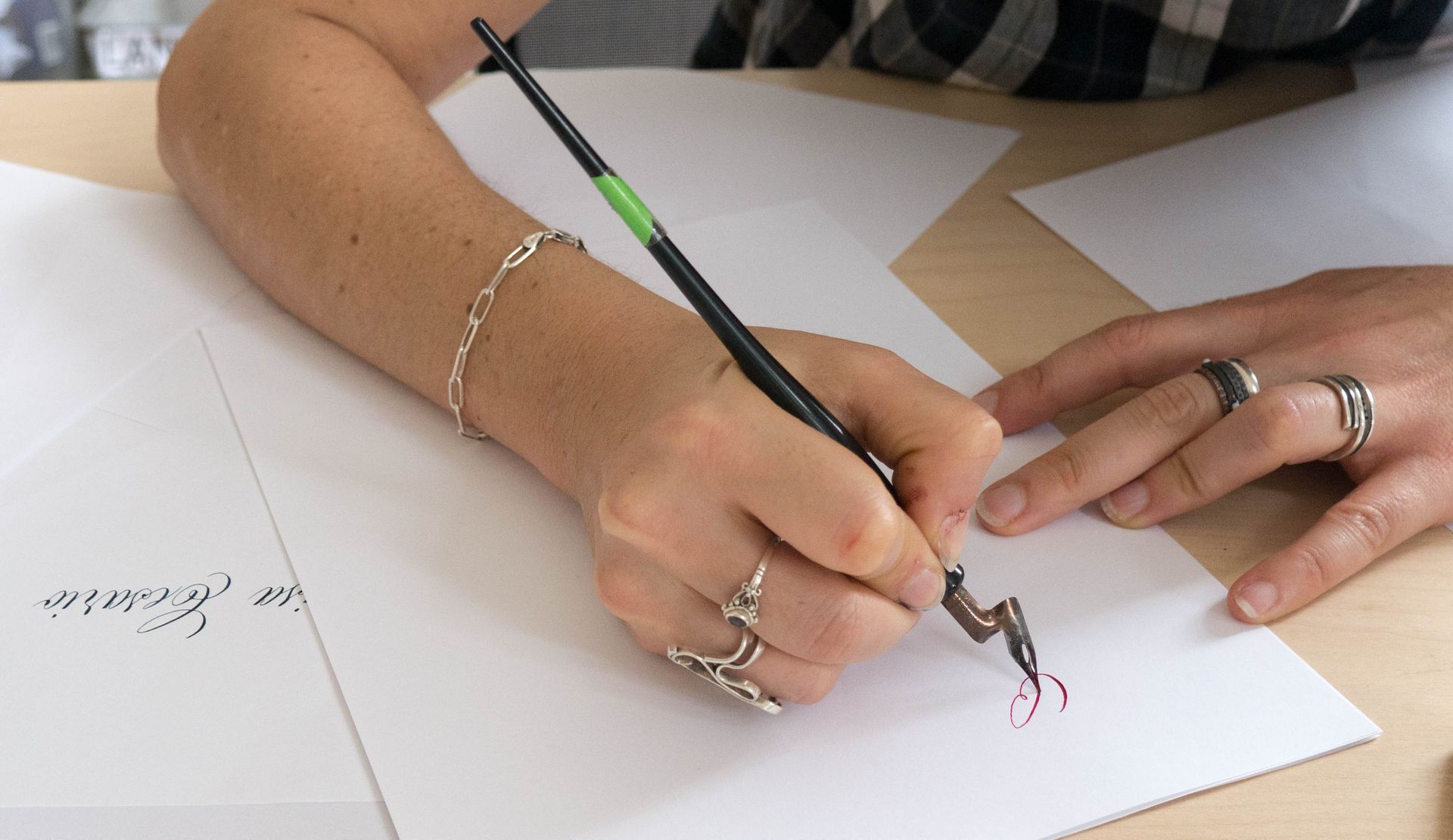
Understanding Calligraphy Pen Holders
A pen holder in calligraphy is the handle that holds the nib, allowing the calligrapher to write with precision and control. It serves as the main tool for holding and guiding the nib while applying ink to paper. Pen holders come in various materials, including wood, plastic, and metal, each offering a different weight and feel to suit individual preferences.
Wooden pen holders feel more natural to the hand due to the organic wood material they are made of. Plastic pen holders are super affordable and I have used a Speedball straight and oblique pen holder for years!
- Please, note that my personal supply recommendations focus on simple and low-key materials that can take you far, as these are the same materials I have been using since my first time holding a calligraphy pen back in 1996 —that is last century!
Straight vs. Oblique Pen Holders
Straight and oblique pen holders are two common tools used in calligraphy, each designed to suit different writing styles and hand positions.
Straight pen holders
Hold the nib in line with the body of the pen and are ideal for scripts that require little to no slant. They provide a natural grip and control, making them a versatile choice for both beginners and experienced calligraphers.
I personally use straight pen holders for the following calligraphy styles:
Roman Capitals,
Modern Carolingian,
Italic, Blackletter and
Neuland calligraphy.

Oblique pen holders
Feature a small flange (usually metal or plastic) that holds the nib at a certain angle. This design is beneficial for right-handed and left-handed calligraphers working with highly slanted scripts like Copperplate and Spencerian.
The angled nib placement helps maintain a consistent slant while reducing hand strain, allowing for smoother, more controlled strokes. Left-handed calligraphers may also benefit from straight pen holders designed to accommodate their writing angle.
Choosing between a straight and an oblique holder depends on personal preference, writing style, and the level of comfort a calligrapher experiences while practicing.
I personally use oblique pen holders for my
Copperplate calligraphy practice.
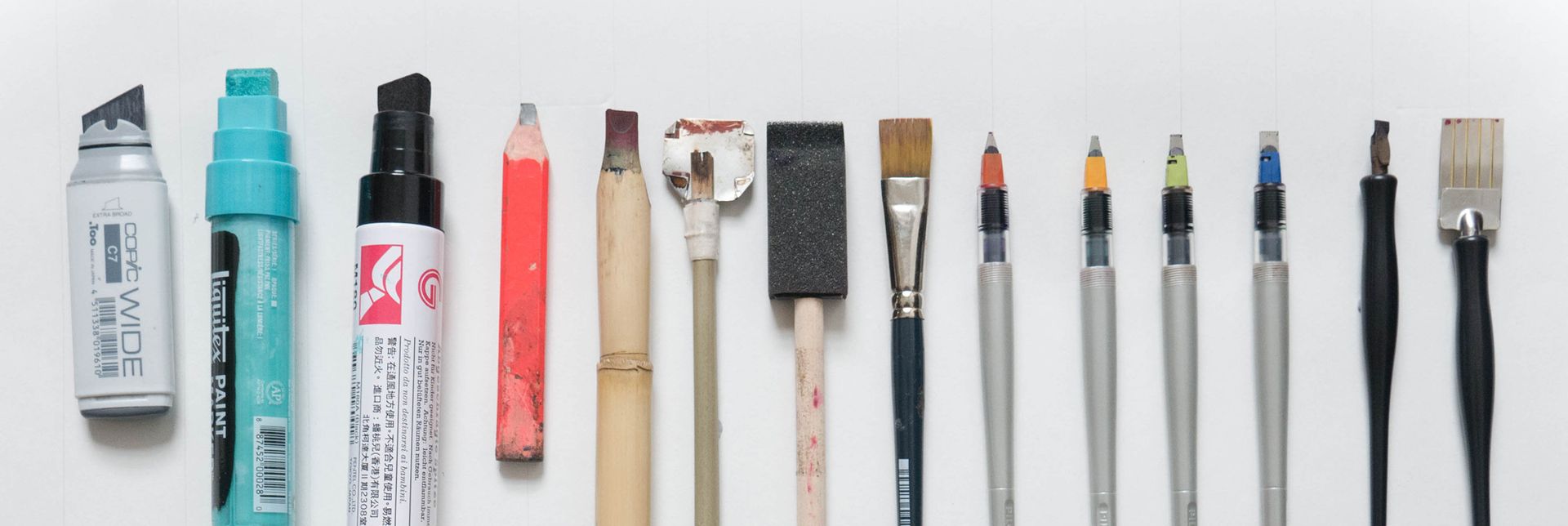
Photo credit: Roci Delapenna. A range of broad-edge writing tools.
Different Types of Calligraphy Pens
We can categorize calligraphy pens into three broad categories:
1. Broad-edge pens
Used for scripts like Roman Capitals, Rustica, Uncial, Half-uncial, Carolingian, Celtic, Italic, Blackletter amongst others. These pens create thick and thin strokes mostly based on the angle of the nib rather than pressure.
2. Pointed flexible pens
Used for scripts like Copperplate and Spencerian. These create line variation through pressure - pressing down creates thicker strokes, releasing pressure creates thinner strokes.
3. Brush pens
Used for modern calligraphy, Copperplate and expressive lettering. These offer the most dramatic line variation and fluidity.
Video credit: This video by Maria Montes explores the different types of nibs used in copperplate calligraphy, focusing on their flexibility and how to test them.
Best Calligraphy Nib Manufacturers for Beginners and Professionals
Notable manufacturers and their distinctive metal nibs include: Mitchell, Brause, Tape, Hunt, Speedball, and Gillott. See a comprehensive description of each below.
Mitchell
Their Mitchell Round Hand broad-edge nibs are valued for exceptional flexibility and sensitivity, though beginners may find them challenging until developing sufficient control and lightness of touch.
I started my Copperplate calligraphy journey (back in 2011!) using a William Mitchell Elbow nib, which is on the stiffer side of the spectrum and ideal for students who have a lot of strength in their hands/ arms or apply way too much pressure against the paper.
Brause
Known for producing very firm, stiff broad-edge nibs that provide a familiar feel similar to ballpoint pens or pencils, making them particularly suitable for novices.
I started my calligraphy journey (back in 1996!) using a Brause nib 3mm, and I'm still using them regularly for all my broad-edge pen work.
Tape
Broad-edge nibs offering moderate flexibility—more responsive than Brause but more forgiving than Mitchell—creating an excellent transitional option for developing calligraphers.
Hunt
Widely recognised for their Speedball nibs, commonly available in art supply stores. Hunt also produces numerous pointed nibs for Copperplate styles, with the #101 Imperial being particularly esteemed.
I have been using Hunt 101 Imperial for my Copperplate calligraphy work since 2021 and I'm in love with this nib! That said, if you are a beginner, see my recommendation below.
The G Nib Series for Beginners
If you are a total beginner, or have been spending only a few hours with your Copperplate calligraphy practice, I strongly recommend using a Nikko G, Zebra G or Tachikawa G nibs. They are great pointed flexible nibs for learning to drive, before purchasing (chipping, denting and/or scraping) a sports' car!
Gillott
For Copperplate calligraphy, many calligraphers use Gillott 303 and Gillott 404, which are really great options as well.
Other manufacturers (Hiro, Esterbrook, etc.) offer diverse options with varying characteristics. Experimentation remains essential for finding nibs that complement your individual technique and writing style.
Speedball
My favourite from this manufacturer is called Speedball Steel Brush Nib. This nib is a unique calligraphy and lettering tool designed to mimic the expressive strokes of a brush while providing the precision and control of a metal nib.
Unlike traditional dip pen nibs, this nib features a flexible, brush-like tip made from fine steel tines, allowing for dynamic thick and thin strokes depending on pressure and angle. Key features:
- Brush-Like Effect: Designed to replicate the look of a brush while maintaining the crisp edges of a metal nib.
- Flexible Steel Tines: Allows for smooth transitions between thick and thin strokes with controlled pressure.
- Ideal for Expressive Lettering: Suitable for calligraphy, sign painting, and expressive script styles.
- Ink Versatility: Can be used with a variety of inks, including traditional calligraphy inks, gouache, and acrylic-based inks.
- Durable Construction: Made of high-quality steel for longevity and consistent performance.
The Speedball Steel Brush Nib is a favourite among calligraphers and letterers looking to bridge the gap between traditional broad-edge nibs and the fluidity of a flat brush.
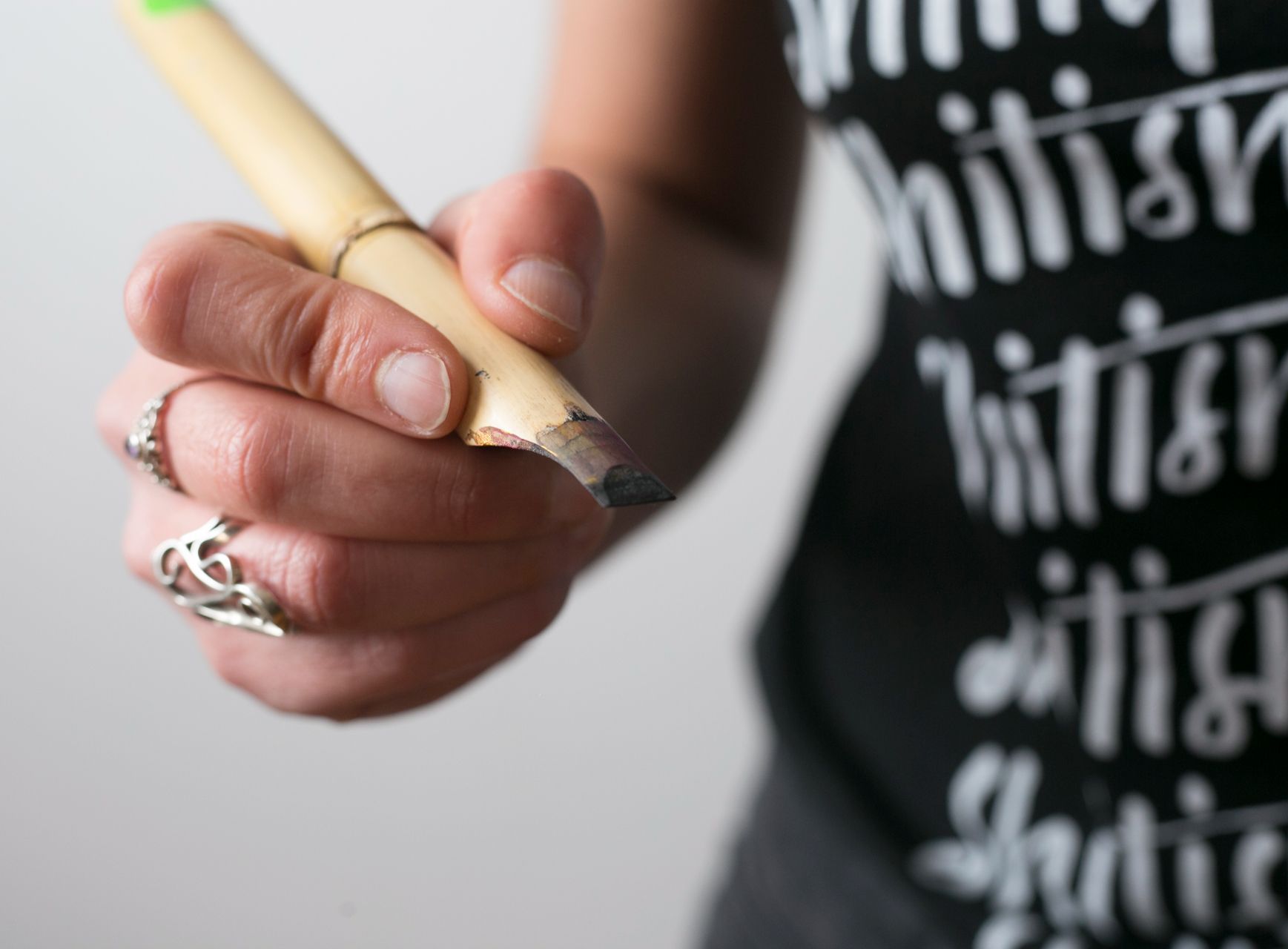
Photo credit: Teagan Glenane.
Traditional Calligraphy Pens: Bamboo and Reed
Bamboo and Reed Pens
One of humanity's earliest writing implements, fashioned from hollow plant stems (typically reed or bamboo). Historically significant as the first tool used with liquid ink on papyrus, reed pens remain valuable for writing on textured surfaces where metal nibs might catch or snag. Their naturally firm yet slightly yielding character produces distinctive marks with organic variation.
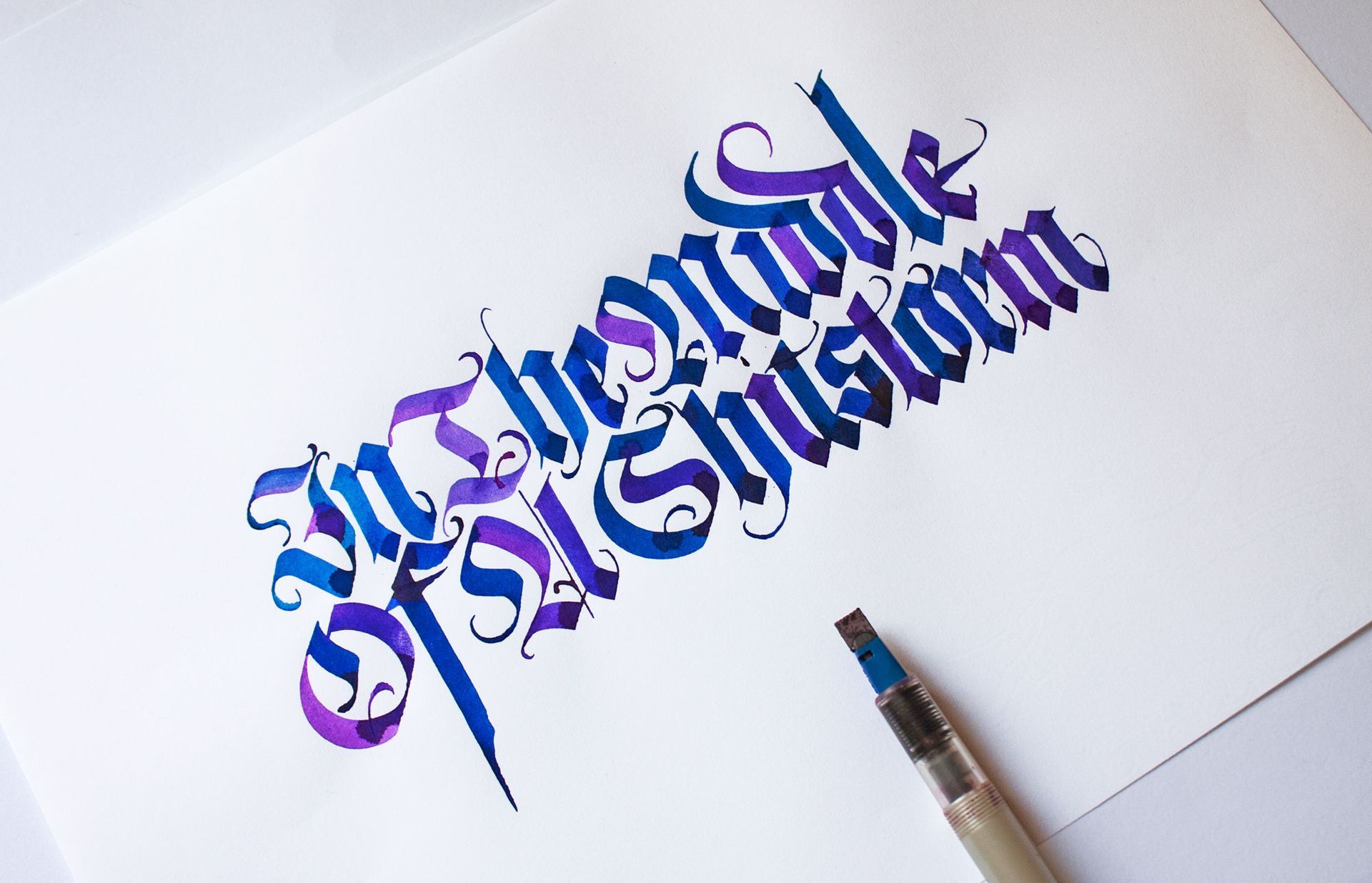
Photo source: 'In the middle of a shitstorm' blackletter calligraphy artwork done with a Pilot Parallel Pen 6mm by Maria Montes.
Best Contemporary Calligraphy Pens for Beginners
In recent years, many calligraphers have started writing with contemporary broad-edge pens including Pilot Parallel and Automatic pens. Let's dive into them!
Pilot Parallel Pens
The Pilot Parallel Pen is a popular calligraphy tool known for its innovative nib design, which consists of two parallel metal plates that allow for smooth ink flow and crisp, consistent strokes. Unlike traditional broad-edge calligraphy pens, this unique construction enables seamless transitions between thick and thin lines and even allows for blending colours.
Available in various nib sizes (ranging between 1.5mm, 2.4mm, 3mm, 3.8mm, 4.5mm and 6.0mm), the Pilot Parallel Pen is widely used for scripts such as Gothicized Italic, Fraktur, Uncial, and other broad-edge calligraphy styles.
It comes with replaceable ink cartridges in a variety of colours, though many calligraphers also refill them with custom inks using a converter or syringe.
Favoured by both beginners and professionals, the Pilot Parallel Pen is appreciated for its smooth writing experience, versatility, and ease of use, making it an excellent choice for calligraphy practice, expressive lettering, and artistic experimentation.
Tip! Pilot Parallel Pens bleed and feather with most types of papers, so my recommendations are:
- Purchase bleedproof paper such as Canson XL marker 70gsm
- Use a Rhodia pad
- You can learn more about paper.
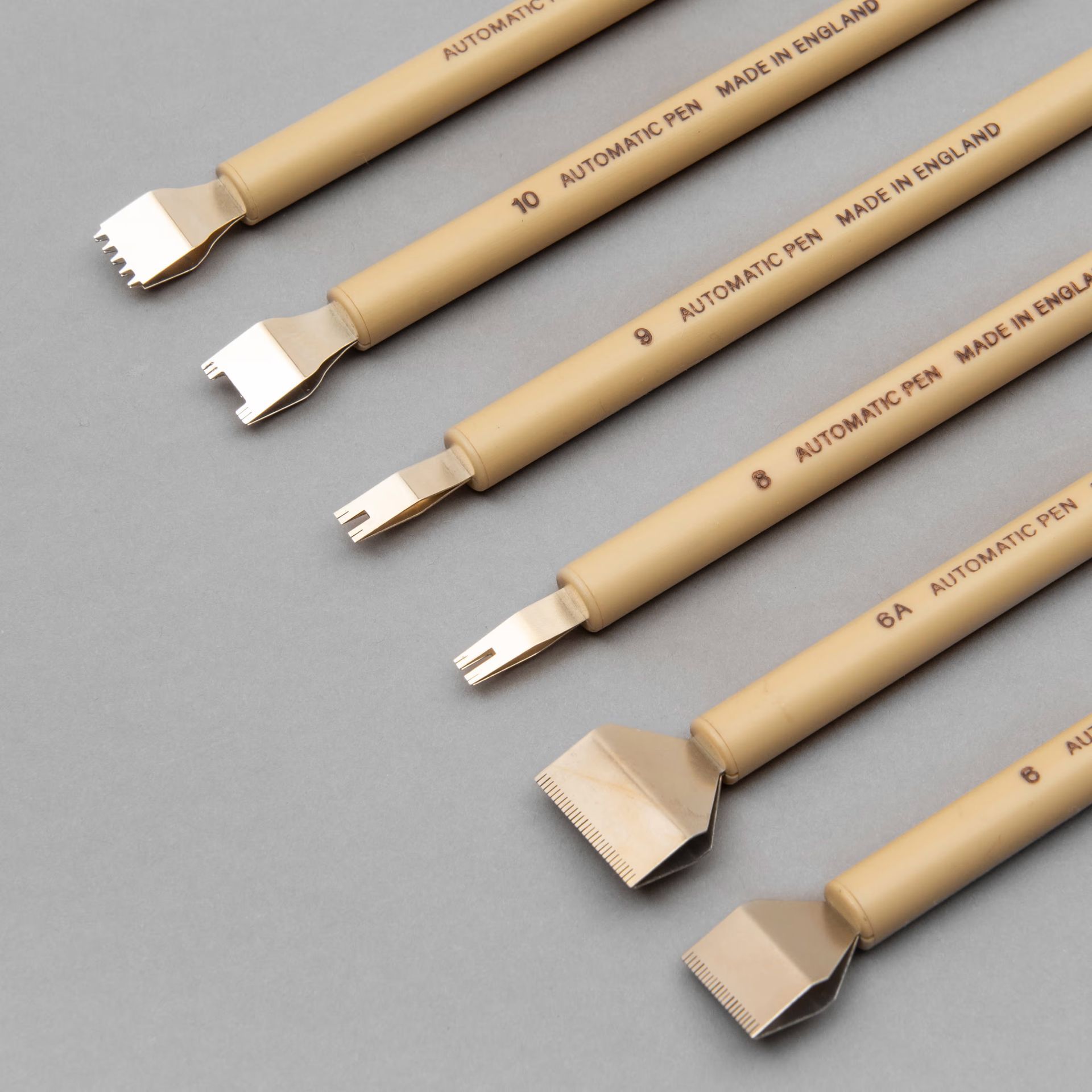
Automatic (Dip) Pens
Automatic Pens are handcrafted in London, England, and are renowned worldwide for their quality and distinctive design. Made from non-rust nickel silver, each pen comes with a non-slip ABS plastic holder for comfortable use.
The range includes thirteen pens:
- Eight plain pens ranging from 1/16″ to 1″
- Four border pens from 1/8″ to 1/2″
- A 1/2″ five-line music ruler
These pens are compatible with all inks, dyes, and gouache.
To maintain their performance:
- Rinsing in clean water is usually sufficient for cleaning
- A sharp craft knife can be used to remove any stubborn debris
- They are typically used with the small serrations facing upwards
- Ink is loaded between the blades using a brush
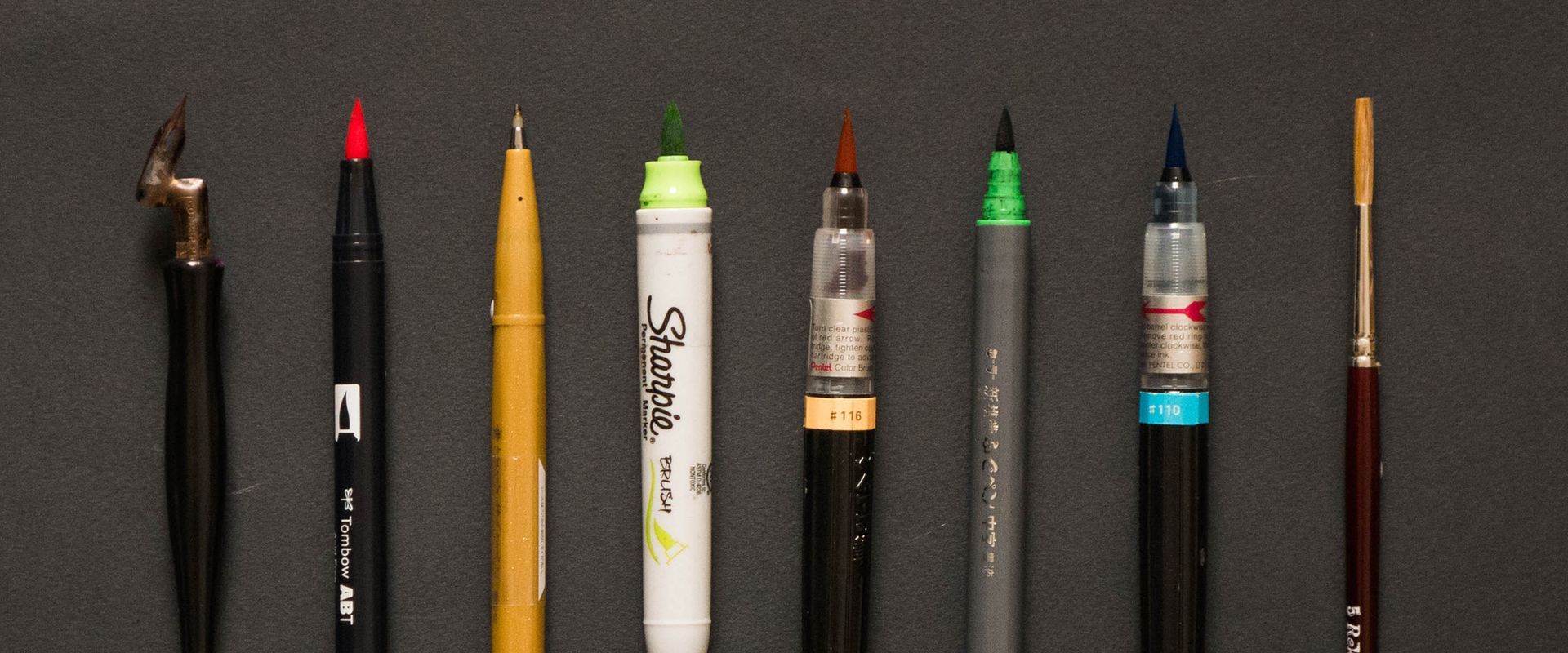
Photo credit: Roci Delapenna. Pointed flexible brush pens and nibs including: William Mitchell Elbow nib, Tombow, Pentel Sign Brush, Sharpie brush, Pentel Aqua Brush pen, Daiso Japanese brush and round
Natural Ox Sable brush. Check them all on my
brush supply section.
Contemporary Brush Pens for Calligraphy
There are many synthetic brush pens in the market including Faber Castell, Tombows, Sharpie, Ecoline, Pentel Aquash Water Brush and Pentel Touch/Fude Sign brushes. I use the last two the most, and I have developed an entire calligraphy course using synthetic/felt brushes.
In my opinion, contemporary calligraphy pens are great as take-away options where you don't need to carry ink with you, and can set up a writing station anytime, anywhere.
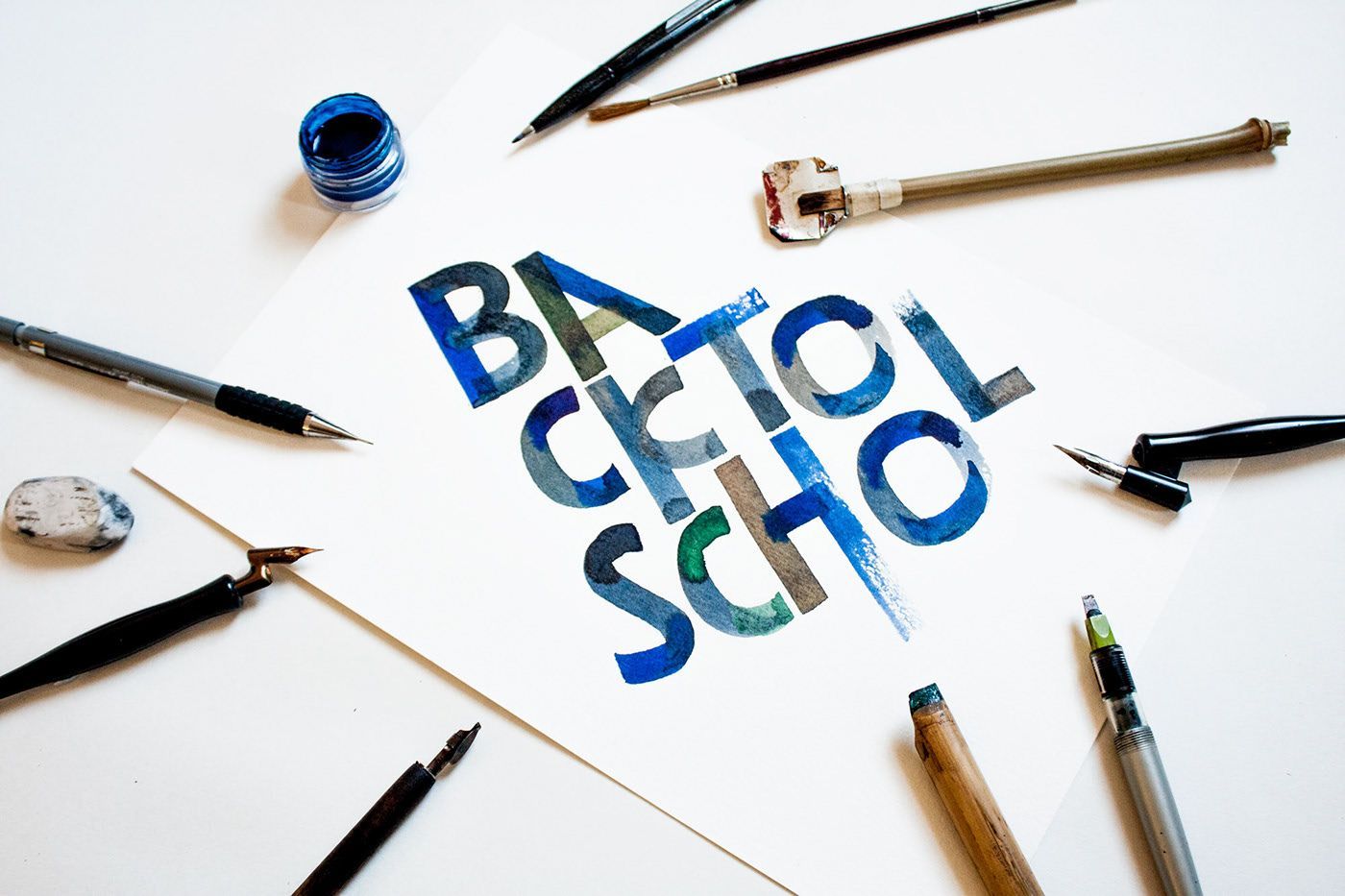
Image credit: 'Back to School' Neuland calligraphy by Maria Montes. Calligraphy pens featured: mechanical pencil, William Mitchell Elbow nib with a straight pen holder, Brause broad-edge nib with a straight pen holder, bamboo pen, Pilot Parallel pen 3.8mm, Nikko G with an oblique pen holder, a broad nib made out of a beer can with a bamboo straight pen holder, round sable ox brush and a Pentel Touch Sign Brush pen.
Alternative Calligraphy Tools for Creative Expression
Beyond conventional metal nibs, innovative calligraphers employ diverse tools to create expressive letterforms, including:
- Drafting ruling pens
- Handmade folded pens from various materials
- Wooden craft sticks
- Foam brushes
- Paper towelling
- Mops (for large-scale work)
- Feathers (both quill and brush ends)
- Markers
- Balsa wood pieces
These alternative instruments offer unique mark-making qualities that expand calligraphic expression beyond traditional forms.
Video title: Broad-edge calligraphy tools. In this video, Maria Montes talks about different broad-edge calligraphy pens and tools you can use for multiple hand styles including and not limited to: Roman Capitals, Rustica, Uncial, Half-Uncial, Carolingian, Celtic/Insular, Blackletter, Italic, Neuland amongst others.
Choosing the Right Calligraphy Pen for Your Skill Level
When selecting calligraphy pens as a beginner, consider these factors:
1. Start with forgiving tools
G-series pointed flexible nibs, Brause broad-edge nibs, or Pilot Parallel Pens offer more stability and are less likely to catch on paper or splatter ink.
2. Consider your calligraphy style
Different scripts require different pens:
- For Italic, Blackletter, Uncial: Use broad-edge pens
- For Copperplate, Spencerian: Use pointed flexible nibs
- For modern, expressive styles: Consider brush pens
3. Budget appropriately
Begin with quality starter tools before investing in expensive pens. A few good quality pens are better than many low-quality ones.
4. Pair with appropriate paper
Even the best pens perform poorly on inappropriate surfaces. Match your paper to your pen and ink combination. Learn more about paper.
5. Progress gradually
Move from firmer nibs to more flexible ones as your skills develop. Master control before attempting tools that require greater precision.
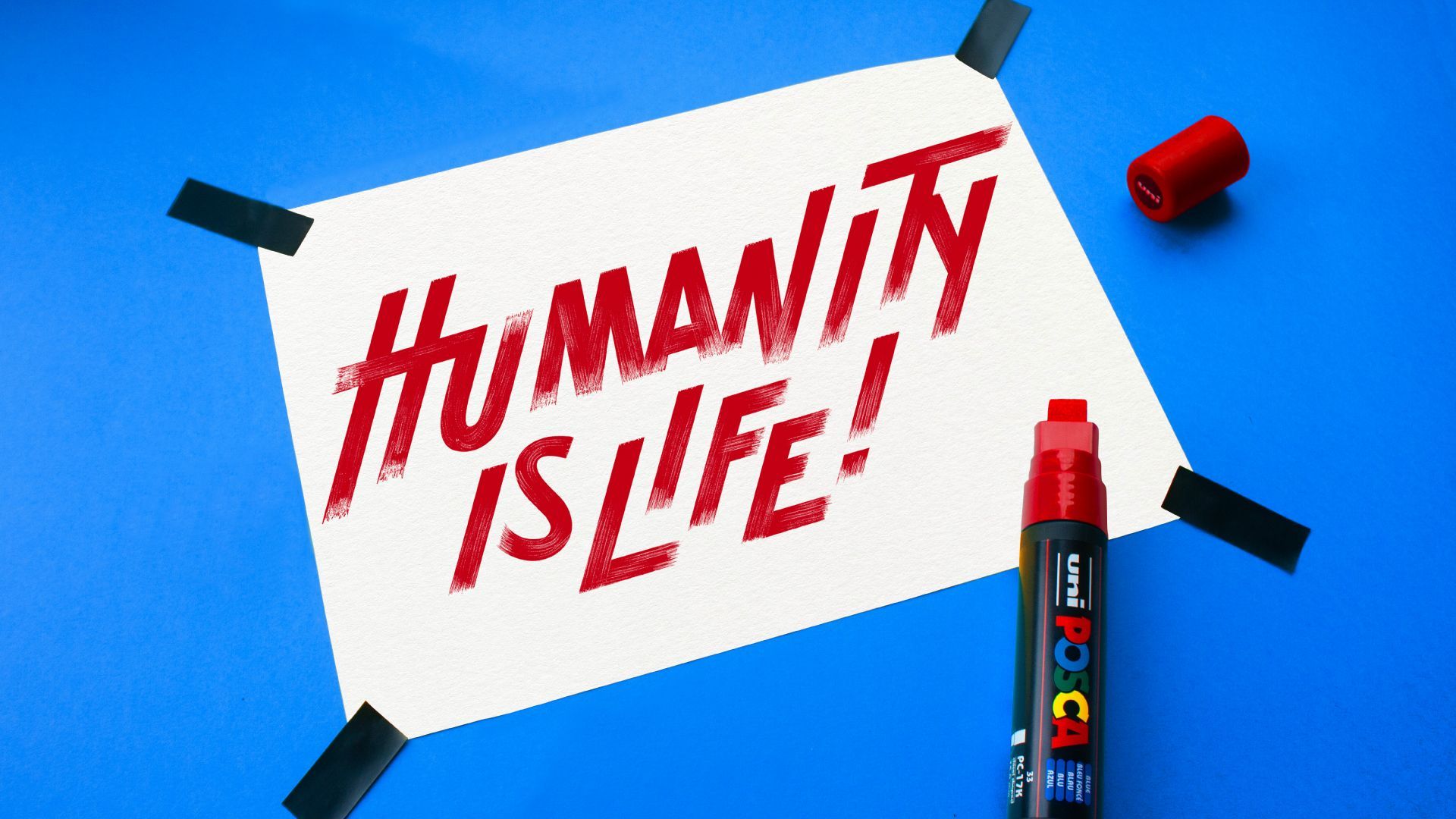
Image credit : Digital editorial design by Maria Montes for Ted Lasso's Apple TV series written by Nate Burgos and published by Design Feast.
Frequently Asked Questions About Calligraphy Pens
What’s the best calligraphy pen for absolute beginners?
For absolute beginners, the Pilot Parallel Pen offers an excellent introduction to broad-edge calligraphy with minimal frustration. For pointed pen calligraphy, start with a Nikko G nib in an oblique pen holder, which provides good control while learning proper pressure techniques.
Can left-handed people use regular calligraphy pens?
Yes! Left-handed calligraphers can use regular calligraphy pens, though they may need to adjust their hand position or paper angle. Specially designed left-handed oblique holders are also available for pointed pen styles, while straight pen holders work well for most left-handed broad-edge writing. Please, note that the manufacturer Brause and Mitchell also produce specific left-handed broad-edge nibs.
How long do calligraphy nibs typically last?
With proper care, quality calligraphy nibs can last for months or even years of regular use. Factors affecting longevity include frequency of use, type of ink, cleaning routine, and writing pressure. Beginners often wear nibs out faster due to applying excessive pressure.
What’s the difference between calligraphy pens and fountain pens?
Calligraphy dip pens:
- Require regular dipping into ink
- Feature replaceable nibs with varying flexibility
- Create dramatic line variation
- No internal ink reservoir
Fountain pens:
- Have built-in ink reservoirs
- Typically offer less dramatic line variation
- Require less frequent refilling
- Some calligraphy-specific fountain pens (like Pilot Parallel) are designed for calligraphic effects with internal ink supply
How should I clean and maintain my calligraphy pens?
Clean nibs thoroughly after each use by rinsing with clean water and gently wiping dry. Remove manufacturing oils from new nibs by briefly dipping in warm water with a drop of dish soap, then rinsing thoroughly. Store nibs in a dry place to prevent rusting, and avoid leaving ink to dry on the nib, which can cause corrosion.
Can I use regular ink with calligraphy pens?
Not all inks work well with calligraphy pens. Use inks specifically formulated for calligraphy like the recommendation in my ink supplies section.
India ink should be used cautiously as it can clog nibs if allowed to dry, while acrylic inks should generally be avoided with fine metal nibs.
Experiment with walnut ink or gouache for excellent results with proper consistency.


